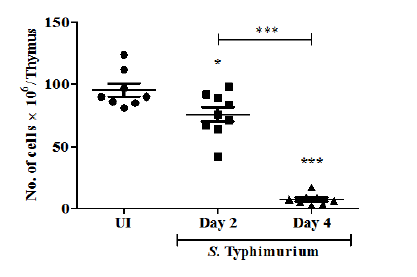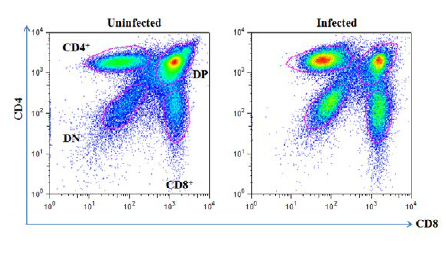Dipankar Nandi

Dipankar Nandi
Professor
Ph.D.: University of California, Berkeley, California, USA
Post-doctoral research:
University of Cincinnati, Ohio, USA
Year of Joining: 1997
Email:nandi@iisc.ac.in
One of the major areas of investigation in our laboratory is to study host responses during Salmonella Typhimurium infection. Using multi-color flow cytometry, we find that during infection immature sub-populations of thymocytes are more affected in terms of differentiation and survival compared to mature thymocytes.
Highlights
- DN and DP thymocytes are reduced during S. Typhimurium-induced thymic atrophy
- Also, the maturation of SP CD4+ and CD8+thymocytes is lowered
The overall objective of our laboratory is to understand the biological responses to different stimuli. Our laboratory works at the interface of microbiology, biochemistry and immunology and we utilize microbial systems as well as the host encoded immune system. Over the years, we have established a diverse array of models and expertise to elucidate the roles of various genes and signals that modulate microbial and host encoded responses. Broadly, the twin areas of interests in our laboratory are: (a) Studying novel microbial genes and unravelling their functions during stress, antibiotic resistance, infection etc., and (b) Understanding the host encoded immune responses.
Several years back, our laboratory identified Peptidase N (PepN), the sole M1 family member in Escherichia coli and Salmonella Typhimurium to be a major aminopeptidase. This area of investigation led us to uncover the roles of Lon protease in the generation of phenotypic antibiotic resistance. Using a combination of approaches, we have studied the roles of non-steroidal anti-inflammatory compounds, e. g. sodium salicylate, acetaminophen etc, in inducing antibiotic resistance. The roles of a transcription factor, MarA, and the AcrAB-TolC efflux pump have been elucidated. We are in the process of screening and identifying compounds in the environment, e. g. herbicides, that may induce antibiotic resistance. In addition, we are investigating the roles of novel genes during phenotypic antibiotic resistance.


Thymocyte subsets are differentially affected during Salmonella Typhimurium infection. The subpopulations of DN and DP thymocytes are greatly reduced during this model of infection-induced thymic atrophy. Further detailed analysis using multi-color flow cytometry has shown that ISP cells, i,e. CD24hiCD3loCD8+ are highly sensitive to infection.Also, an increase in less mature CD24hiCD3hi single positive CD8+ and CD4+ thymocytes is observed during infection. Finally, infection-induced cortisol and interferon-gamma affected thymocytes subsets.
There are two auxiliary areas under host encoded immune responses that our laboratory has contributed: T cell biology & Inflammatory responses. T cells are required for cellular immunity and play key roles during the adaptive immune response. T cells differentiate in the thymus and the loss of thymocytes results in thymic atrophy. We have standardized a model of thymic atrophy by orally administering Salmonella Typhimurium, an intracellular pathogen. We are studying multiple aspects during this process: the sub-populations of thymocytes, different signaling pathways etc. We hope to better understand the processes and identify molecules that will ameliorate thymic atrophy.
Inflammation is important for host defence; however, a dysregulated response can cause immunopathology, which harms the host. We have standardized an in vivo mouse model of sepsis mediated by Salmonella Typhimurium. Sepsis is a major disorder and responsible for a large percentage of deaths in intensive care units in hospitals. Recently, we have shown that Nos2-encoded nitric oxide is crucial for host resistance in this model of infection. Importantly, pre-treatment with a NO donor increases the survival of infected Nos2 mice. Current efforts are directed towards understanding the roles of additional signalling pathways that affect different cellular responses. In addition, we are also developing a photonics based approach to diagnose sepsis and shock in human patient samples, using Raman spectroscopy.
- Biochemical and functional characterization of cold shock protein E (CspE) during stress and virulence of Salmonella Typhimurium; Council of Scientific and Industrial Research (CSIR); 2016-2019;
- Studies on the regulation and roles of free radicals during Salmonella Typhimurium infection-induced thymic atrophy; Science and Engineering Research Board (SERB); 2017-2020;
- Development of Raman Spectroscopy as a surveillance technology for antimicrobial resistance; BIRAC; 2019- 2020;
- Evaluating the potential and understanding the mechanisms of herbicides and plant growth regulators in the induction of antibiotic resistance in bacteria. Department of Biotechnology; 2018-2021;
- Verma, T., Podder S., Mehta M., Singh S., Singh A., Umapathy S. and Nandi, D. (2019) Raman spectroscopy reveals distinct differences between two closely related bacterial strains, Mycobacterium indicuspranii and Mycobacterium intracellulare. Analytical and Bioanalytical Chemistry – in press
- Ray, S., Da Costa, R., Das, M., and Nandi, D. (2019) Interplay of cold shock protein E with an uncharacterized protein, YciF, lowers porin expression and enhances bile resistance in Salmonella Typhimurium. J. Biol. Chem. 294, 9084-9099
- Verma, T., Bhaskarla, C., Sadhir, I., Sreedharan, S. and Nandi, D. (2018) Non-steroidal anti-inflammatory drugs, Acetaminophen and Ibuprofen, induce phenotypic antibiotic resistance in Escherichiacolioles of marAandacrB. FEMS Microbiol. Lett. 365, fny 251
- Yadav, S., Pathak, S., Sarikhani, M., Majumdar, S., Ray, S., Chandrasekar, B. S., Adiga, V., Sundaresan, N. R. and Nandi, D. (2018) Nitric oxide synthase 2 enhances the survival of mice during Salmonella Typhimurium infection-induced sepsis by increasing reactive oxygen species, inflammatory cytokines and recruitment of neutrophils to the peritoneal cavity. Free Radic. Biol. Med.116, 73-87
- Majumdar, S., Deobagkar-Lele, M., Adiga, V., Raghavan, A., Wadhwa, N., Ahmed, S. M., Rananaware,S.R., Chakraborty, S., Joy, O. and Nandi, D. (2017) Differential susceptibility and maturation of thymocyte subsets during Salmonella Typhimurium infection: insights on the roles of glucocorticoids and Interferon- gamma. Sci. Rep. 7, 40793
Ph.D. Students 6
Undergrads 2
Postdocs 1
Trainees 2